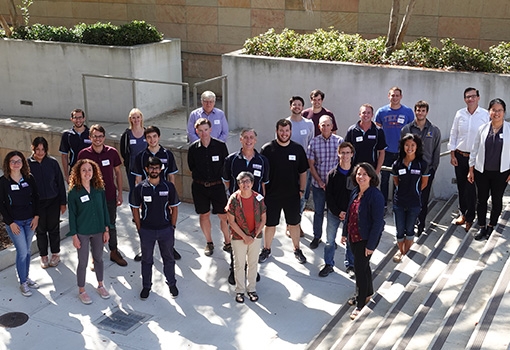A team of researchers at UC Santa Barbara, The University of Texas at Austin, and the Lawrence Berkeley National Laboratory (LBNL), which is taking novel membrane-based approaches — and new materials to enable them — to change how we purify water, has received a $12 million grant from the Department of Energy (DOE) through its Energy Frontier Research Center (EFRC) Program. The DOE announced the four-year extension last week as part of its $400 million investment to establish and continue forty-three EFRCs across the country to accelerate basic science understanding and discovery in energy-related fields.
Launched through a four-year, $10.75 million grant from the DOE in 2018 and headquartered in the Cockrell School of Engineering at UT Austin, the Center for Materials for Water and Energy Systems (M-WET) unites experts from three institutions to apply state-of-the-art materials synthesis, characterization, and modeling to address basic science knowledge gaps hindering the creation of next-generation polymer membranes to filter chemically contaminated water for re-use. M-WET leaders say the center’s vision and past contributed to the renewal.
“In its first four years, M-WET scientists worked across numerous disciplinary boundaries to address basic science challenges related to water-purification membranes that no one group or discipline could address alone,” said Benny Freeman, M-WET director and the William J. (Bill) Murray, Jr. Endowed Chair of Engineering in the McKetta Department of Chemical Engineering at UT Austin.
Freeman added that M-WET produced a substantial body of impactful literature, launched the careers of many early-stage researchers, spawned a startup focused on novel lithium-extraction processes, and used advanced spectroscopy to probe new and fundamental molecular-level properties of membranes.
“Looking toward the future, we will build upon these successes, discovering fundamental design rules to prepare novel membranes, training the next generation of interdisciplinary scientists in this area, and positively impacting water and energy security for our future,” he said.
Synthetic polymer membranes are widely used to purify water, mainly because they are more energy efficient than competing technologies. But current membranes were not designed for, and are not suitable for, applications involving water that is heavily contaminated with organic and inorganic components resulting from, for instance, oil and gas production. M-WET’s unique team of researchers combines expertise in water chemistry, polymer and materials science, surface chemistry, and advanced materials characterization methods with extensive practical knowledge of water treatment and membrane processes. Scientists are focused on discovering critical fundamental scientific principles to enable predictive design and large-scale manufacturing of new polymer-based membrane materials.
“Energy and water are inextricably linked, in that the purification of water is undeniably energy intensive, and the production of energy generates uniquely contaminated water. This center brings together the expertise developed over the past decades to make designer polymers with the ability to design scalable membrane separations processes to address this unique challenge,” said Rachel Segalman, chair of UCSB’s Chemical Engineering Department and an M-WET associate director. “Now that we’ve established ourselves as a research center, the renewal allows us to evolve, reframe what we are doing, and pursue new frontiers of science to develop impactful water- treatment technologies.”
For example, Segalman says that M-WET will add research thrusts, including one focused on how to process membranes, with the goal of learning how to design porous materials that are efficient, effective, and reproducible on an industrial scale. Ions are the subject of a second new research focus, bringing together the ion and battery communities to study ion transport in water. Additional faculty, who specialize in those areas, and their graduate students and postdoctoral researchers will become involved with the center as a result. The expanded scope of research promises to speed both the identification and the preparation of new membrane materials with superior properties for energy-efficient recycling, repurposing, and purifying of water.
“We will be specifically seeking to understand and exploit the interaction of water and solutes with polymer chemistries to make new, highly efficient membranes,” said Segalman. “While this center is focused on fundamental design rules, we anticipate having a major impact both in developing novel membranes and in training a new generation of scientists who bridge polymer and membrane science, chemical engineering, and environmental engineering.”
Established by the Department of Energy’s (DOE’s) Office of Science in 2009, EFRCs have produced more than ten thousand peer-reviewed scientific publications and generated hundreds of inventions at various stages of the patent process.
UCSB electrical and computer engineering professor Jon Schuller is part of the Quantum Materials for Energy-Efficient Neuromorphic Computing (Q-MEEN-C) Research Center, which was also selected for a four-year extension by the DOE. Based at UC San Diego, the center seeks to identify, develop, and characterize quantum materials to enable energy-efficient neuromorphic computing, which would make it possible to solve problems in a way that replicates human brains.

The DOE awarded a four-year, $12 million extension to The Center for Materials and Energy Systems (M-WET).
